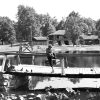calsfoundation@cals.org
Gene Bearden (1920–2004)
Gene Bearden was a major league baseball player in the late 1940s and early 1950s. After serving in World War II, he crafted a seven-year career that was highlighted by his role as a starting pitcher on the 1948 Cleveland Indians team that won the World Series.
Henry Eugene (Gene) Bearden was born on September 5, 1920, in Lexa (Phillips County) to Henry and Ella Bearden. With his father working as a machinist for the Missouri Pacific Railroad, the family moved a number of times, but Bearden spent much of his youth playing sandlot baseball in Tennessee. Graduating from Technical High School in Memphis, Tennessee, in 1938, the left-handed pitcher whose boyhood hero was Lou Gehrig signed with the Philadelphia Phillies in 1939.
Bearden began his path to the major leagues pitching for Moultrie of the Class D Georgia-Florida League. There, the eighteen-year-old won five games and lost eleven during the 1939 season. The following year, pitching for Miami Beach of the Class D Florida East Coast League, he thrived, posting a record of 18–10 with a 1.63 earned-run average. He also spent 1941 with Miami Beach, winning seventeen and losing seven with a 2.40 ERA. While he started the 1942 season with Savannah in the Class B South Atlantic League, following his sale by the Phillies to the New York Yankees, he switched to the league’s Augusta franchise, where he compiled a 4–4 record before he enlisted in the U.S. Navy during World War II.
According to news stories published soon after the end of the war, Bearden had been stationed on the USS Helena, one of the few ships that had survived the 1941 attack on Pearl Harbor, in the South Pacific near the Solomon Islands, when in the early morning of July 6, 1943, the ship was struck by three torpedoes. As the Helena sank, other ships in the fleet made every effort to rescue survivors, but ultimately 168 members of the Helena’s 900-man crew died. It was reported that Bearden had suffered a major head wound and one of his knees “was a mass of wounded flesh.” However, later research published by the Society for American Baseball Research asserts that this story was a fabrication and that Bearden was serving in Florida on the USS SC-1330 when the Helena went down. The research further states that his knee problems, which ultimately caused his honorable discharge from the navy in 1945, had been from a football injury in 1939.
Returning to baseball after his navy service, he won fifteen games for the Yankees’ Binghamton farm team, and the following season, under the watchful eye of Casey Stengel, who taught him how to throw a knuckleball, Bearden won another fifteen pitching for the Oakland Oaks of the Pacific Coast League. That winter, on December 26, 1946, Bearden was traded to the Cleveland Indians as part of a five-player trade.
In 1947, Bearden got a rough introduction to the major leagues when, in his first and only appearance for the Indians that season, he faced four batters and recorded only one out while giving up two hits and three runs. He also walked one and threw a wild pitch. His ERA was 81.00. Back in Oakland, Bearden rebounded from his major league fiasco and turned in a solid season, compiling a record of 16–7 with an ERA of 2.86. It was enough to get him an invitation to the Indians spring training camp, and there he earned spot on the opening day roster.
Although he did not make an appearance until the team’s twelfth game of the season, beginning with that debut on May 8 he won his first three starts and six of his first seven. After a brief slump, when he lost four in a row—four of the seven he was to lose all year—he ultimately finished with a record of 20–7 and a league-leading ERA of 2.43 with fifteen complete games. Indeed, despite having only one-third of a major league inning under his belt, Bearden pitched 229 and two-thirds innings to earn a second-place finish in the Rookie of the Year balloting. More importantly, combining with future Hall of Famers Bob Lemon and Bob Feller, who won twenty and nineteen, respectively, Bearden helped the Indians not only win the American League pennant—a title that was clinched when Bearden won his twentieth game in the one-game playoff with the Red Sox—but also the World Series, where he pitched a shutout in the third game and got the save in the final game, retiring Tommy Holmes on a fly ball for the final out. It was only the team’s second World Series win.
The 1948 season was the peak of Bearden’s career, and he never approached the same level of performance, although he remained in the major leagues until the end of the 1953 season. He was put on waivers by the Indians in August 1950, when he was picked up by the Washington Senators. The following April, the Senators put him on waivers, where he was picked up by the Detroit Tigers, who subsequently traded him to the St. Louis Browns in February 1952. His final stop was Chicago after the White Sox picked him up off waivers in March 1953.
Bearden pitched four more years in the minor leagues from 1954 to 1957, doing stints with Seattle, San Francisco, Sacramento, and Minneapolis, but even though he won eighteen games for San Francisco in 1955 and fifteen for Sacramento in 1956, he never got another chance in the majors. After the 1957 season, he retired, having compiled a career major league record of forty-five wins, thirty-eight losses, and an ERA of 3.96.
While his overall career was mediocre at best, his performance in 1948 was enough to inspire his selection by the fans for induction into the Cleveland Hall of Fame, one of 100 players chosen for their contributions to Cleveland baseball.
Following the end of his baseball career, Bearden moved back to Arkansas. He owned several hamburger restaurants as well as a car dealership and a storage company but was perhaps most well-known locally for his long stint as the manager of the country club and golf course in Helena (Phillips County). In Helena, also coached the local American Legion baseball team, and the city’s Gene Bearden Stadium is named after him.
Bearden married Juanita Collier in 1943, and they had a son and soon divorced. He married Lois Jane Shea on January 18, 1945. They had a son, John Shea Bearden, and a daughter, Jean Bearden.
Bearden died in Alexander City, Alabama, on March 18, 2004, from congestive heart failure. He is buried in Sunset Memorial Park in Walnut Corner (Phillips County).
For additional information:
“Gene Bearden.” Baseball Reference. https://www.baseball-reference.com/players/b/beardge01.shtml (accessed July 3, 2023).
Hennessy, M. Shawn. “Gene Bearden.” SABR BioProject. https://sabr.org/bioproj/person/Gene-Bearden/ (accessed July 3, 2023).
William H. Pruden III
Ravenscroft School
 Arkansas Sports Hall of Fame
Arkansas Sports Hall of Fame Recreation and Sports
Recreation and Sports World War II through the Faubus Era, 1941 through 1967
World War II through the Faubus Era, 1941 through 1967




I had the pleasure of knowing this man as an American Legion baseball player. I met him when I was fifteen and continued to play for Coach Bearden for three more years. Our friendship would continue up to the day he died. I learned so much from this good man. I remained in contact with Coach Bearden, visiting him and his wife every time I came back home. He made a big impact on my life and inspired me to dedicate my life to the game of baseball. The love of baseball has taught me so much about character, honor, and rules.
I have two of his baseball cards that he autographed and gave to me as gifts. They are very special to me. This was an epic article on his life!